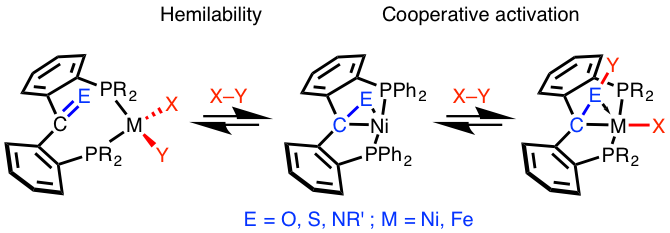
Research in the Moret group focusses on the organometallic chemistry of mid-to-late first-row transition metals (Fe–Cu) with applications to homogeneous catalysis. To harvest the full potential of these metals, we develop new types of supporting ligands and investigate novel reactivity patterns arising from metal-ligand interactions. We currently investigate two main research lines.
1) Carbon–heteroelement multiple bonds as cooperative acceptor ligands.
In this research line, we investigate new types of organic ligands that incorporate C=O and C=N double bonds as acceptor moieties, i.e. ligand parts that bind to a metal by mostly withdrawing electron density. We investigate the ability of such ligands to engage in cooperative activation of small molecules, aiming at understanding their mechanism of action and designing improved catalysts.

Periodic Trends in the Binding of a Phosphine-Tethered Ketone Ligand to Fe, Co, Ni, and Cu. Verhoeven, D. G. A.; van Wiggen, M. A. C.; Kwakernaak, J.; Lutz M.; Klein Gebbink R. J. M.; Moret, M.-E.* Chem. Eur. J. 2018, 24, 5163–5172.
Formation of exceptionally weak C-C bonds by metal-templated pinacol coupling. Folkertsma, E.; Benthem, S. H.; Witteman, L.; van Slagmaat, C. A. M. R.; Lutz, M.; Klein Gebbink, R. J. M.; Moret, M.-E.* Dalton Trans. 2017. 46, 6177-6182.
Metal-Ligand Cooperation at Tethered π-Ligands. Verhoeven, D. G. A.; Moret, M.-E.* Dalton Trans., 2016, 45, 15762–15778.
Coordination of a Diphosphine–Ketone Ligand to Ni(0), Ni(I), and Ni(II): Reduction-Induced Coordination. Saes, B. W. H.; Verhoeven, D. G. A.; Lutz, M.; Klein Gebbink, R. J. M.; Moret, M.-E.* Organometallics 2015, 34, 2710.
2) Silicon-based anionic ligands

In this research line, we investigate a novel ligand class based on anionic silicon-based ligands. These ligands are formally isoelectronic to their widely-used phosphorus analogues, but considerably stronger donors. However, the instability of these metal complexes prevents their general use in catalysis. We developed a strategy to sterically and electronically stabilize the anionic Si center and showed that it is able to form stable compounds with metals of the first transition series. We are now investigating the properties of these molecules both as supporting ligands and as potential organocatalysts themselves.
A Free Silanide from Nucleophilic Substitution at Silicon(II). Witteman, L.; Evers, T.; Lutz, M.; Moret, M.-E.*, Chem. Eur. J. 2018 DOI:10.1002/chem.201801435.
Hydrosilylation in Aryliminopyrrolide-Substituted Silanes. Witteman, L.; Evers, T.; Shu, Z.; Lutz, M.; Klein Gebbink, R. J. M.; Moret, M.-E.* Chem. Eur. J. 2016, 22, 6087–6099.